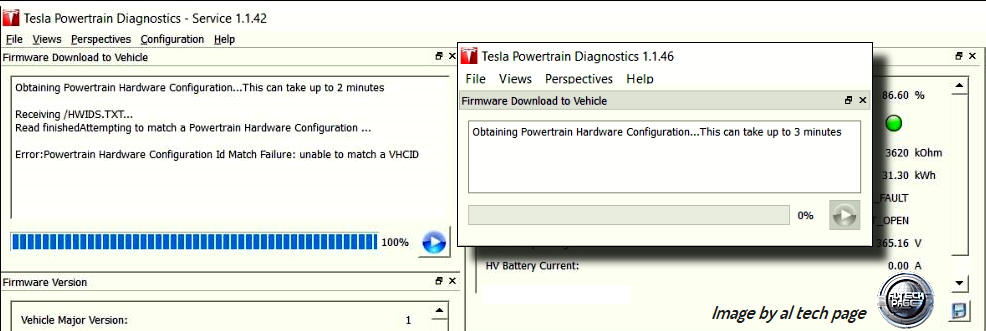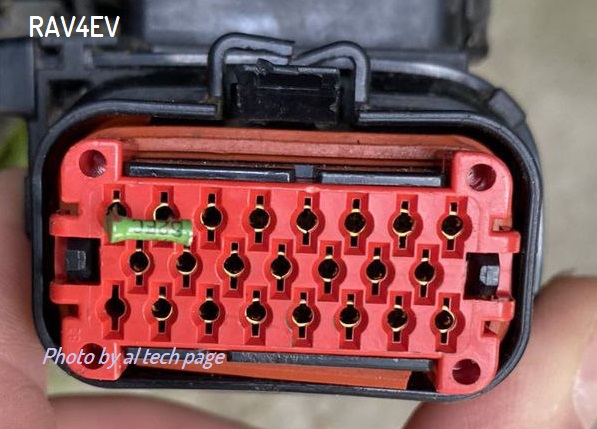You are using an out of date browser. It may not display this or other websites correctly.
You should upgrade or use an alternative browser.
You should upgrade or use an alternative browser.
Errors After Inverter control board replacement and problems with re-flash.
- Thread starter Arlin
- Start date

Help Support Toyota Rav4 EV Forum:
This site may earn a commission from merchant affiliate
links, including eBay, Amazon, and others.
Yes.Ok thank you VERY much for your help. Are you Available Friday? I plan to work on this Friday as I have the day free while my boys are at School.
Notes.
But we need to coordinate/agree on the time (the difference with Ukraine is 7 hours?).
And only if there are no rocket attacks and drone attacks on my city by Russian Nazis.
Do you use WhatsApp and/or Telegram? Let me know in a private message.
p.s.
If possible, fill out and submit this form https://diag.alflash.com.ua/rav4ev-questionnaire/
It's like a "patient card" in a medical institution
Last edited:
In my work I use version 1.1.42. because it has more necessary functions.1) He's in a very different timezone (Odesa) that B.C., so you'll need careful coordination.
2) His screenshot link shows that, if you're using TPD 1.1.46, you (should) have the firmware:
View attachment 438
Maybe double-check?
And version 1.1.46 was installed on an old laptop as a “newfangled” toy. But I don't use this version.
The firmware file firmware-release-1.3.101.tar that I have had since December 2017 is absolutely the same size as the one I downloaded in April 2024.
https://alflash.com.ua/2019/to_rav4ev/1.3.101.png

Last edited:
Yes,Ok thank you VERY much for your help. Are you Available Friday?
Reference to reflash.
https://alflash.com.ua/2019/to_rav4ev/to_reflash/1.3.101.pdf
https://alflash.com.ua/2019/to_rav4ev/to_reflash/EV_system_Software_Update.pdf
https://alflash.com.ua/2019/to_rav4ev/to_reflash/1300_1500.pdf
For now, we can state that thanks to the efforts of Tesla programmers, the RAV4EV diagnostic program v.1.1.46 has become much worse!
https://alflash.com.ua/2019/to_rav4ev/1.1.42.png
I assume that this is revenge for past alleged grievances...

https://alflash.com.ua/2019/to_rav4ev/1.1.42.png
I assume that this is revenge for past alleged grievances...

You've convinced me, I guess. I am gearing up to provide 1.1.42 license keys. I'll do a separate thread for that, in about two weeks.

$129.99
MAXLINER Floor Mats 2 Row Liner Set Black for 2006-2012 Toyota RAV4 Without 3rd Row Seat
AutoAccessoriesGarage

$16.06
$16.91
MICTUNING Upgraded Dual USB Port 6.4A QC3.0 Quick Charger with Blue LED Digital Voltmeter Replacement for Toyota, Compatible with Cellphone iPad PDA Laptop GPS (Surface Size 1.6 x 0.9 inches)
Nado Stuff (Authorized Dealer)
Arlin
Well-known member
Guys, I need to do a long write up and share all I have learned. I owe a HUGE thanks to alflash.
He has went above and beyond to try to help me out. The short version is I have damaged my OEM boards from the inverter. I tried repairing it and tried to run the Rav 4 and it didn't work.
So then I got a 2013 sport drive unit and tried the main control board from it... Still didn't go... Then started digging and found alflash and this forum and found TPD 1.1.46 and was trying it to re-flash the drive unit control board with no luck. Well today alflash tried to help me and spent ~3 hr helping me while he was having his city bombed from the war! I can't thank him enough. It didn't fix the rav 4 because the control board is likely wrong. But It helped me learn what I need to know to fix it. I made another attempt to repair the OEM control board and will put it in and try it again. I tried 1 time before with repairing the OEM control board and it didn't work. But I didn't realize I might not have had the disconnect down all the way. So maybe the OEM control board was ok the first time.
I will keep you posted.
The other good news is I think I got a good enough deal on the sport drive unit that I can put the AEM control board in it with new bearings and sell it for a profit.
When I am on my feet a bit I will send something to alflash! Right now my ex wife is trying to bankrupt me... So hoping one day that will end and I will be in a better place to pay it back and pay it forward.
-Arlin
He has went above and beyond to try to help me out. The short version is I have damaged my OEM boards from the inverter. I tried repairing it and tried to run the Rav 4 and it didn't work.
So then I got a 2013 sport drive unit and tried the main control board from it... Still didn't go... Then started digging and found alflash and this forum and found TPD 1.1.46 and was trying it to re-flash the drive unit control board with no luck. Well today alflash tried to help me and spent ~3 hr helping me while he was having his city bombed from the war! I can't thank him enough. It didn't fix the rav 4 because the control board is likely wrong. But It helped me learn what I need to know to fix it. I made another attempt to repair the OEM control board and will put it in and try it again. I tried 1 time before with repairing the OEM control board and it didn't work. But I didn't realize I might not have had the disconnect down all the way. So maybe the OEM control board was ok the first time.
I will keep you posted.
The other good news is I think I got a good enough deal on the sport drive unit that I can put the AEM control board in it with new bearings and sell it for a profit.
When I am on my feet a bit I will send something to alflash! Right now my ex wife is trying to bankrupt me... So hoping one day that will end and I will be in a better place to pay it back and pay it forward.
-Arlin
Arlin, thank you for the kind words addressed to me.
Good luck overcoming the difficulty!
I assume that the donor inverter board is in good order. And the failure of reprogramming is caused by another reason, which I will talk about later with screenshots and videos (?).
Offtopic. Yesterday, the russian Nazis fired six missiles at my city. As a result of the shelling, one person was killed and eight were injured. One Nazi missile hit the center of a huge warehouse, destroying dozens of tons of chicken meat and semi-finished products from a well-known Ukrainian food producer.
https://dumskaya.net/pics/b7/picturepicture_17159657574494628444872_53444.jpg
Good luck overcoming the difficulty!
I assume that the donor inverter board is in good order. And the failure of reprogramming is caused by another reason, which I will talk about later with screenshots and videos (?).
Offtopic. Yesterday, the russian Nazis fired six missiles at my city. As a result of the shelling, one person was killed and eight were injured. One Nazi missile hit the center of a huge warehouse, destroying dozens of tons of chicken meat and semi-finished products from a well-known Ukrainian food producer.
https://dumskaya.net/pics/b7/picturepicture_17159657574494628444872_53444.jpg
Last edited:
Arlin
Well-known member
Arlin
Well-known member
Well, HVIL faults are relatively easy to track down. The High Voltage Interlock Loop is a series of (60ohms * n) resistors. If any connector that carries HV is not fully mated, the BMS sees the wrong loop resistance and refuses to close the contactors. That's actually one of the easier things to track down, with just an ohmmeter.
Do you have 60 ohms between (from memory!) pins 7 & 8 on the LDU data connector (the black 12-way connector on the LDU)? If yes, check resistance from either of those LDU's pins to ground: should be ∞.
If those tests pass, then you have to look at other HV connectors you've touched. Typically, the main HV disconnect/fuse under the passenger seat isn't fully seated, for example. Or some other HV connector that you've had off, would be the first places to inspect.
---
These are from the early Model S and so are not 100% identical to the RAV4 EV . . . but it's representative:


Source: SB-10052449-4313 HVIL Diagnostic Guide
HVIL faults get hairy to track down when corrosion gets to the various harness mating connectors; in the Model S, there are intermediate connectors (such as X939 and X950 in the diagram above) and those can become intermittent: the bane of electronic diagnostics everywhere.
Do you have 60 ohms between (from memory!) pins 7 & 8 on the LDU data connector (the black 12-way connector on the LDU)? If yes, check resistance from either of those LDU's pins to ground: should be ∞.
If those tests pass, then you have to look at other HV connectors you've touched. Typically, the main HV disconnect/fuse under the passenger seat isn't fully seated, for example. Or some other HV connector that you've had off, would be the first places to inspect.
---
These are from the early Model S and so are not 100% identical to the RAV4 EV . . . but it's representative:


Source: SB-10052449-4313 HVIL Diagnostic Guide
HVIL faults get hairy to track down when corrosion gets to the various harness mating connectors; in the Model S, there are intermediate connectors (such as X939 and X950 in the diagram above) and those can become intermittent: the bane of electronic diagnostics everywhere.
Last edited:
1.
2. Take a look Test Plan in https://alflash.com.ua/2019/to_rav4ev/hvil.pdf or in your 1.1.42 version
3. RAV4EV Cruise Control , Hybrid Control System , Shift Control https://alflash.com.ua/2019/to_rav4ev/2013wirEV.pdf
4. Cheating the HVIL system when checking it
https://alflash.com.ua/2019/to_rav4ev/hvil60.jpg

2. Take a look Test Plan in https://alflash.com.ua/2019/to_rav4ev/hvil.pdf or in your 1.1.42 version
3. RAV4EV Cruise Control , Hybrid Control System , Shift Control https://alflash.com.ua/2019/to_rav4ev/2013wirEV.pdf
4. Cheating the HVIL system when checking it
https://alflash.com.ua/2019/to_rav4ev/hvil60.jpg

Last edited:
Arlin
Well-known member
Thank you so much. 7-8 measure open!Well, HVIL faults are relatively easy to track down. The High Voltage Interlock Loop is a series of (60ohms * n) resistors. If any connector that carries HV is not fully mated, the BMS sees the wrong loop resistance and refuses to close the contactors. That's actually one of the easier things to track down, with just an ohmmeter.
Do you have 60 ohms between (from memory!) pins 7 & 8 on the LDU data connector (the black 12-way connector on the LDU)? If yes, check resistance from either of those LDU's pins to ground: should be ∞.
If those tests pass, then you have to look at other HV connectors you've touched. Typically, the main HV disconnect/fuse under the passenger seat isn't fully seated, for example. Or some other HV connector that you've had off, would be the first places to inspect.
---
These are from the early Model S and so are not 100% identical to the RAV4 EV . . . but it's representative:
View attachment 445
View attachment 446
Source: SB-10052449-4313 HVIL Diagnostic Guide
HVIL faults get hairy to track down when corrosion gets to the various harness mating connectors; in the Model S, there are intermediate connectors (such as X939 and X950 in the diagram above) and those can become intermittent: the bane of electronic diagnostics everywhere.
I will dig into this.
I dbl-checked, and pins 7 & 8 on the LDU are the HVIL lines, yes:

Source: 2014 RAV4 EV electrical diagram (Tesla parts only)

Source: 2014 RAV4 EV electrical diagram (Tesla parts only)
Arlin
Well-known member
Will go through that after lunch. .
The speed sensor fault? I did have the speed sensor plugged in. Maybe it's faulty? It only gives me that fault when I try to push the brake pedal and try to get it to go ready
The speed sensor fault? I did have the speed sensor plugged in. Maybe it's faulty? It only gives me that fault when I try to push the brake pedal and try to get it to go ready
The inverter does NOT see the rotation of the rotor and, according to Tesla’s stupid logic, writes about a sensor failure. Although the reason may be, for example, a jammed rotor.Will go through that after lunch. .
The speed sensor fault? I did have the speed sensor plugged in. Maybe it's faulty? It only gives me that fault when I try to push the brake pedal and try to get it to go ready
Arlin
Well-known member
Arlin
Well-known member
Arlin
Well-known member
It shifts into drive but then gives a check power steering warning and goes back to neutral
I ran my LDU with no half-shaft installed, and the lower ball joints disconnected.
I seem to get the power steering warning whenever the HV contactors open; the DC-DC Converter goes offline, no support for the 12v system, and the PS system is the first to issue a "low voltage" warning.
I bet your contactors open, then the PS warning comes on the IC.
I seem to get the power steering warning whenever the HV contactors open; the DC-DC Converter goes offline, no support for the 12v system, and the PS system is the first to issue a "low voltage" warning.
I bet your contactors open, then the PS warning comes on the IC.
Similar threads
- Replies
- 39
- Views
- 6K
- Replies
- 17
- Views
- 8K
- Replies
- 16
- Views
- 20K































